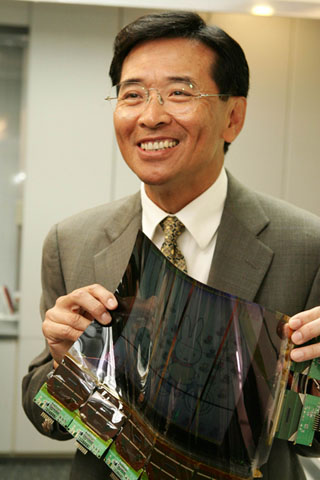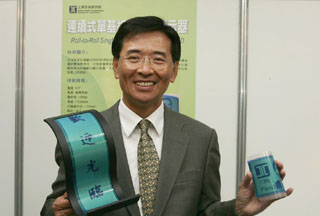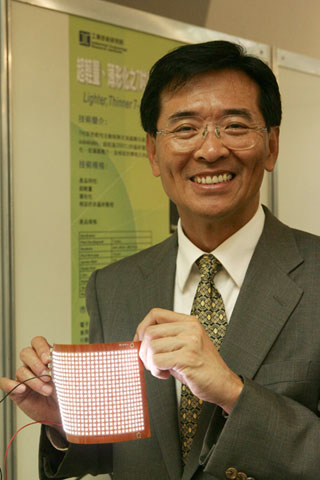Research Center Unveils Futuristic Flexible Displays
2008/01/29 | By Quincy LiangA new type of technology is expected to revolutionize display screens by making them lighter, thinner, and, most importantly, flexible. The changes in store were demonstrated at the recent Flex Your Life-2007 ITRI Display Technology Workshop, at which the Display Technology Center (DTC) of the Industrial Technology Research Institute (ITRI) introduced its latest R&D achievements. On show were prototypes of some products that had never before been seen in Taiwan.
The DTC showed off 18 achievements related to flexible-display technology at the workshop, including not only the latest flexible displays themselves but also materials, equipment, production processes, systems, and future application concepts.
The DTC's general director, John Chen, noted that his organization was exhibiting its flexible displays for the first time. These exhibits marked an advance in the center's technological strength, following its development of entry-level composite (plastic/glass) flexible displays.

Chen went on to say that flexible-display technology is looking at a rosy future in all aspects-international investment, market-sale forecasts, and R&D advancement, among others. Citing examples of government and venture-capital investment in Europe and the U.S., he stressed that all performance figures are on an upward trend and are rapidly forming a new sector. The forecast of the size of the industry in 2010 has been heightened from just US$17.8 million when the prediction was first made in 2003 to US$62.1 million now.
After years of hard work, the DTC has made a number of major technical breakthroughs for its flexible display products. At the recent workshop, for instance it highlighted its latest bendable/foldable color cholesterol display, which is made with two plastic substrates and cuts both weight and thickness by more than 50% compared with conventional counterparts. The new product also features a wide viewing angle, simple production processes, and the ability to be produced by the roll-to-roll method.

Innovative Applications
This new development has a wide range of potential applications, including e-banners at exhibition venues, electronic signboards, and e-walls used to create virtual visualization backgrounds for specific theme environments.
The DTC has applied for 34 patents related to these innovative displays, and expects to enter into cooperation projects with local private companies with an eye to commercialization.
The center also displayed a wireless transmission system for real-time signboards, hospital bed information displays, and electronic price tags. This improved system solves the traditional wireless-transmission problems of dead zones, making it possible for information displayed at target locations to be updated instantly and remotely, effectively slashing labor costs.
Workshop participants observed a 10.4-inch single-layer monochrome cholesteric flexible display that was less than one centimeter thick and was bendable and foldable, making it totally unlike the heavy, fragile traditional displays. The DTC explained that its flexible displays are produced with advanced pixelized vacuum filling (PVF) technology to inject red, green, and blue cholesterols into the pixels on a single layer, a vast improvement over the traditional three-layer, heavier, thicker color cholesteric displays.
Another new DTC innovation on show at the workshop was a 7-inch flexible active matrix (AM) liquid-crystal display (LCD) made with high-transparency plastic substrates that overcome the usual problem of expansion and shrinkage of materials during the 200-degree Celsius production process. This cutting-edge display also featured the advantages of light weight, thinness, impact-resistance, and high resolution. A newly developed bendable module with LED backlight packaged on a flexible printed-circuit board (PCB) was also used in the AM flexible display.

The DTC expects this new display to be widely adopted for use in high-end cellphone handsets, personal digital assistants (PDAs), and other 3C (computer, communication, and consumer electronic) products.
Also on display at the event was the DTC's latest multi-function optical diffuser film made of pure transparent polymer material using the one-piece-form production method. This film provides the same effect as four traditional diffuser films, the center claimed. This advanced film features low cost, environmental friendliness (since it uses much less that the usual amount of materials), light weight, thinness, and durability.




